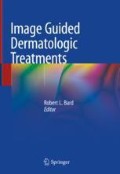Abstract
Ultrasound allows noninvasive burn depth evaluation and on-site diagnosis with high-resolution point-of-care units. Wound healing and complications may be serially observed. Nonradiopaque foreign bodies quickly detected allow image-guided removal with decreased morbidity. 3D volumetric mapping shows nerves and vessels as well as fragments that lie outside the initial point of entry.
Access this chapter
Tax calculation will be finalised at checkout
Purchases are for personal use only
References
Monstrey S, Hoeksema H, Verbelen J, et al. Assess of burn depth and healing potential. Burns. 2008;34:761–9.
Iftimia N, Ferguson D, Mujat M, et al. Combined reflectance confocal microscopy/optical coherence tomography imaging for skin burn assessment. Biomed Opt Express. 2013;4(5):680–95.
Iraniha S, Cinat M, Vanderkam V, et al. Determination of burn depth with non contact ultrasonography. J Burn Rehabil. 2000;21:333–8.
Foster F, Zhang M, Zhou Y, et al. A new ultrasound instrument for in vivo microimaging of mice. Ultrasound Med Biol. 2000;26:63–71.
Tantray MD, Rather A, Gull Y, et al. Role of ultrasound in detection of radiolucent foreign bodies in extremities. Surg Trauma Limb Reconstr. 2018;13(2):81–5.
Fakoor M. Prolonged retention of an intramedullary wooden foreign body. Pak J Med Sci. 2006;22:78–9.
Freund EI, Weigl K. Foreign body granuloma: a cause of trigger thumb. J Hand Surg Br. 1984;9:210.
Choudhari KA, Muthu T, Tan MH. Progressive ulnar neuropathy caused by delayed migration of a foreign body. Br J Neurosurg. 2001;15:263–5.
Meurer WJ. Radial artery pseudoaneurysm caused by retained glass from hand laceration. Pediatr Emerg Care. 2009;25:255–7.
Flom LL, Ellis GL. Radiologic evaluation of foreign bodies. Emerg Med Clin North Am. 1992;10:163–76.
Little CM, Parker MG, Callowich MC, et al. The ultrasonic detection of soft tissue foreign bodies. Invest Radiol. 1986;21:275–7.
Harcke TH. Sonographic localization and management of metallic fragments. Mil Med. 2012;177:988–92.
Author information
Authors and Affiliations
Corresponding author
Editor information
Editors and Affiliations
Rights and permissions
Copyright information
© 2020 Springer Nature Switzerland AG
About this chapter
Cite this chapter
Bard, R.L. (2020). Imaging of Dermal Trauma: Burns and Foreign Bodies. In: Bard, R. (eds) Image Guided Dermatologic Treatments. Springer, Cham. https://doi.org/10.1007/978-3-030-29236-2_7
Download citation
DOI: https://doi.org/10.1007/978-3-030-29236-2_7
Published:
Publisher Name: Springer, Cham
Print ISBN: 978-3-030-29234-8
Online ISBN: 978-3-030-29236-2
eBook Packages: MedicineMedicine (R0)

